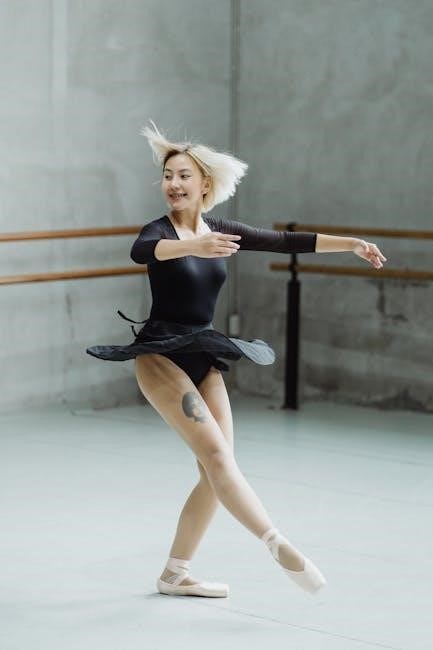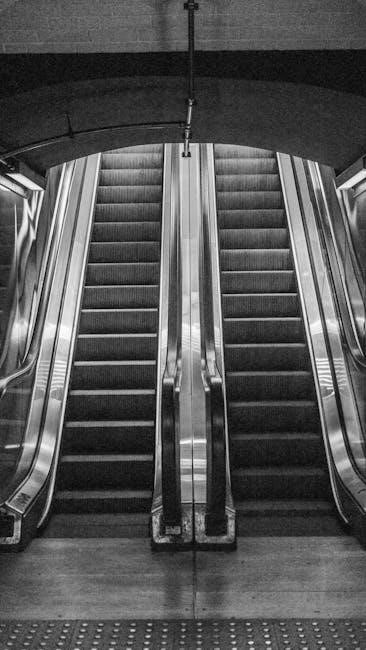
built to move 10 tests pdf
Built to Move offers a simple yet effective approach to enhancing mobility and well-being through 10 essential tests and practices, providing a clear path to improved physical function and overall health.
Overview of the Program
Built to Move is designed as a comprehensive program centered around a simple formula: 10 tests, 10 physical practices, and 10 ways to enhance bodily function. The program focuses on improving mobility, reducing discomfort, and promoting overall well-being. It introduces essential habits that can be easily incorporated into daily routines, helping individuals move more freely and live fully. The system assesses key areas such as hip range of motion, balance, core stability, and breathing patterns through its 10 tests. These assessments are paired with targeted practices like mobilization exercises, dynamic stretching, and postural corrections. The program also includes a 21-day schedule to gradually integrate these practices, making it accessible and sustainable for users of all fitness levels. By addressing both physical and functional aspects, Built to Move aims to empower individuals to take control of their health and mobility.
The Importance of Mobility and Well-Being
Mobility and well-being are foundational to a healthy, active lifestyle, enabling individuals to perform daily tasks with ease and maintain independence. Built to Move emphasizes that good mobility reduces discomfort and enhances physical function, contributing to overall well-being. The program’s 10 tests and practices are designed to assess and improve key areas such as hip range of motion, balance, and breathing patterns. By addressing these factors, individuals can prevent injuries, improve posture, and increase energy levels. The program’s focus on mobility and well-being ensures that users can maintain a high quality of life, moving freely and living fully. Regular practice of the recommended exercises and habits fosters long-term health benefits, making mobility a cornerstone of daily wellness.
Structure of the Built to Move System
The Built to Move system is organized into a clear, three-part framework: 10 diagnostic tests, 10 physical practices, and a 21-day implementation plan. The tests assess various aspects of mobility, such as hip range, balance, and breathing patterns, providing a baseline for improvement. Each test corresponds to a specific practice, ensuring targeted development of strength, flexibility, and coordination. The program’s structure is user-friendly, with practices designed for daily integration. The 21-day schedule guides gradual adoption of these exercises, allowing individuals to build habits progressively. This structured approach ensures that users can systematically enhance their mobility and overall well-being, achieving lasting results through consistent and focused effort. The system’s clarity and organization make it accessible to everyone, regardless of fitness level or experience.

The 10 Essential Tests in Built to Move
The program features 10 comprehensive assessments evaluating mobility, strength, balance, and posture. These tests provide insights into physical limitations and set the foundation for targeted improvement.

Test 1: Hip Range of Motion Assessment
The hip range of motion assessment evaluates the flexibility and mobility of the hip joint. It helps identify limitations that may affect movement and overall performance. By measuring the range of motion, individuals can pinpoint areas needing improvement. This test is crucial for understanding how hip mobility impacts daily activities and exercises. Addressing restrictions here can prevent injuries and enhance mobility. The assessment involves specific movements, such as flexion, extension, and rotation, to gauge joint function. Results are scored to determine if improvements are needed. Regular practice of recommended exercises can lead to better hip mobility and overall well-being. This foundational test sets the stage for the rest of the program.
Test 2: Sit-and-Rise Test for Mobility
The Sit-and-Rise Test evaluates lower body strength, balance, and mobility by assessing how well an individual can sit down and stand up without support. Participants are scored on a 10-point scale, with higher scores indicating better mobility and independence. This test focuses on leg strength, trunk control, and overall coordination. It is a simple yet effective way to identify limitations in movement patterns that may affect daily activities. Regular practice of recommended exercises can improve performance and reduce the risk of mobility-related issues. The test is a key component of the Built to Move program, providing insights into areas that need attention for enhanced physical function and well-being.
Test 3: Balance and Trunk Control Evaluation
The Balance and Trunk Control Evaluation assesses an individual’s ability to maintain stability and proper posture. This test focuses on core stability, which is essential for overall mobility and preventing injuries. Participants are evaluated on their ability to hold steady positions and transition smoothly between movements. The evaluation highlights imbalances in strength and flexibility, particularly in the trunk and lower body. By identifying weaknesses, individuals can target specific exercises to improve their balance and stability. Strong trunk control is vital for maintaining good posture and performing daily activities with ease. This test provides a clear benchmark for tracking progress and ensuring comprehensive physical well-being through the Built to Move program.
Test 4: Leg Strength and Flexibility Assessment
Test 4 evaluates leg strength, flexibility, and coordination, essential for optimal mobility and injury prevention. It identifies imbalances in muscle groups such as quadriceps, hamstrings, and calves, which are vital for activities like walking, running, and climbing stairs. This assessment provides a foundation for enhancing leg mobility and overall lower body function. By targeting these areas, individuals can improve their ability to perform daily tasks and athletic movements effectively. Strong legs are crucial for stability, balance, and energy efficiency, reducing the risk of injuries and enhancing overall performance. This test is a cornerstone of the Built to Move program, aimed at boosting mobility, reducing discomfort, and promoting long-term well-being through targeted exercises and practices.
Test 5: Breathing Pattern Analysis
Test 5 focuses on evaluating breathing patterns to optimize respiratory efficiency and overall well-being. Proper breathing is fundamental for physical performance, stress reduction, and energy levels. This assessment identifies whether breathing is diaphragmatic or shallow, impacting posture, movement efficiency, and oxygen supply. By improving breathing techniques, individuals can enhance endurance, reduce muscle tension, and promote relaxation. The analysis provides insights into how breathwork influences mobility and daily activities, offering a pathway to better respiratory health. Addressing breathing patterns is a critical component of the Built to Move system, aiming to integrate mindful breathing into daily routines for improved physical and mental well-being. This test is essential for achieving a balanced and efficient approach to movement and health.
Test 6: Postural Alignment Check
Test 6 evaluates postural alignment to identify misalignments that may hinder mobility and increase injury risk. Proper posture is crucial for efficient movement, reducing strain on muscles and joints. This assessment examines key areas such as spinal alignment, shoulder positioning, and pelvic balance. Poor posture can lead to discomfort, limited range of motion, and long-term musculoskeletal issues. By addressing postural imbalances, individuals can improve their overall mobility, enhance athletic performance, and reduce the risk of chronic pain. The test provides actionable insights to correct alignment, promoting better movement patterns and long-term well-being. This evaluation is a cornerstone of the Built to Move system, ensuring a strong foundation for optimal physical function.

Test 7: Core Stability Test
Test 7 focuses on assessing core stability, a critical component of overall mobility and physical function. The core muscles, including the abdominals and lower back, play a vital role in maintaining proper posture, generating power, and preventing injury. This test evaluates the ability to maintain a stable spine during movement, measuring strength, control, and endurance. Poor core stability can lead to inefficient movement patterns and increased risk of harm. By identifying weaknesses, individuals can target specific exercises to enhance core function. Improved core stability not only boosts athletic performance but also supports daily activities, reducing the likelihood of lower back pain and promoting better overall mobility and balance.
Test 8: Shoulder Mobility Assessment
Test 8 evaluates shoulder mobility, essential for maintaining proper movement patterns and preventing injuries. The shoulders are a complex joint, and limited mobility here can affect activities like reaching, lifting, and overhead movements. This assessment measures range of motion, flexibility, and strength in the shoulder region. It identifies restrictions or imbalances that may lead to poor posture or chronic discomfort. By improving shoulder mobility, individuals can enhance their overall upper body function, reduce the risk of injury, and perform daily tasks with greater ease and efficiency. Addressing shoulder mobility is crucial for maintaining long-term physical health and functional independence.
Test 9: Ankle and Foot Mobility Test
Test 9 focuses on assessing ankle and foot mobility, which are critical for balance, stability, and efficient movement. The ankles and feet play a vital role in activities such as walking, running, and maintaining proper posture. This test evaluates the range of motion, flexibility, and strength in the ankle joint and surrounding muscles. Limited mobility in this area can lead to issues like poor gait, increased injury risk, and chronic lower body discomfort. Improving ankle and foot mobility enhances overall lower extremity function, supports athletic performance, and reduces the likelihood of injuries. Addressing this area is essential for maintaining optimal movement patterns and long-term physical health.

Test 10: Full-Body Movement Assessment
Test 10 is a comprehensive evaluation of full-body movement, designed to assess overall mobility, coordination, and functional capacity. This test integrates various aspects of movement, including flexibility, strength, balance, and range of motion across all major joints. It provides insights into how well the body works as a unified system, identifying potential limitations or imbalances. By examining movement patterns, individuals can pinpoint areas that may benefit from targeted exercises or practices. Improving full-body movement not only enhances physical performance but also promotes better posture, reduces injury risk, and supports long-term mobility. This assessment serves as a holistic measure of overall physical function and readiness for daily activities or athletic endeavors.

The 10 Physical Practices to Enhance Mobility
These practices include targeted exercises for hips, core, shoulders, and ankles, plus breathing techniques and postural corrections, designed to improve flexibility, strength, and overall mobility effectively.

Practice 1: Hip Mobilization Exercises
Hip mobilization exercises are designed to enhance range of motion and reduce stiffness. These exercises target key areas like the hip flexors, glutes, and piriformis. By improving hip mobility, individuals can reduce the risk of injury and enhance overall movement efficiency. The exercises often include dynamic stretches and controlled movements that promote joint lubrication and muscle flexibility. Regular practice helps maintain optimal hip function, which is essential for activities such as walking, running, and squatting. Incorporating these exercises into a daily routine can lead to better posture, reduced discomfort, and improved athletic performance. Consistency is key to achieving long-term benefits.
Practice 2: Core Strengthening Routine
The core strengthening routine in Built to Move focuses on improving stability, balance, and overall physical resilience. A strong core is essential for maintaining proper posture, reducing lower back pain, and enhancing athletic performance. The exercises included in this practice target the abdominal muscles, obliques, and lower back, promoting functional strength. Techniques such as planks, bird-dog exercises, and pelvic tilts are commonly used to engage the core effectively. Regular practice helps improve intra-abdominal pressure, which is vital for spinal stability. By incorporating these exercises into your daily routine, you can build a solid foundation for better movement patterns and reduce the risk of injuries. Consistency is key to achieving lasting results and improving overall well-being.
Practice 3: Dynamic Stretching for Flexibility
Dynamic stretching is a key practice in Built to Move, designed to enhance flexibility and prepare the body for movement. Unlike static stretches, dynamic stretches involve continuous, flowing movements that mimic real-life actions, such as arm circles, leg swings, and torso twists. These exercises improve range of motion, reduce muscle tension, and boost circulation. By incorporating dynamic stretching into your routine, you can increase joint mobility, reduce the risk of injury, and enhance overall physical performance. Regular practice also promotes better posture and reduces stiffness, making it an essential component of the Built to Move program for long-term flexibility and well-being.
Practice 4: Breathing Techniques for Relaxation
Breathing techniques are a cornerstone of the Built to Move program, focusing on enhancing relaxation and reducing stress. These practices, such as diaphragmatic breathing and box breathing, help calm the nervous system and improve oxygen flow. By incorporating these techniques, individuals can reduce tension, enhance focus, and prepare their bodies for physical activity. Regular breathing exercises also promote better sleep quality, reduce muscle tightness, and improve overall well-being. The program emphasizes the importance of conscious breathing as a tool to enhance mobility, reduce discomfort, and create a foundation for optimal physical function. These simple yet powerful practices are designed to be integrated into daily routines for lasting benefits.

Practice 5: Postural Correction Exercises
Postural correction exercises are designed to improve alignment, reduce discomfort, and enhance overall mobility. These practices focus on strengthening the muscles that support proper posture, such as those in the upper back, shoulders, and core. Techniques like chest opens, shoulder blade squeezes, and neck stretches help counteract the effects of prolonged sitting or poor alignment. By incorporating these exercises into daily routines, individuals can reduce muscle imbalances, alleviate back and neck pain, and promote better breathing and movement patterns. The Built to Move program emphasizes the importance of consistent practice to develop awareness and maintain optimal posture, leading to improved long-term physical well-being and reduced risk of injury.
Practice 6: Shoulder Mobility Drills
Shoulder mobility drills are essential for maintaining flexibility and strength in the shoulder joint, which is crucial for everyday movements and preventing injuries. These exercises target the muscles and connective tissues around the shoulders, improving range of motion and reducing stiffness. Techniques such as arm circles, wall slides, and cross-body stretches are commonly used to enhance mobility. Regular practice helps alleviate shoulder tension, common in individuals with sedentary lifestyles or poor posture. By incorporating these drills, individuals can improve their ability to perform overhead movements and reduce the risk of shoulder-related discomfort. Consistency is key, as these exercises are designed to be simple yet effective for long-term shoulder health and overall mobility.
Practice 7: Balance and Stability Training
Balance and stability training is a critical component of the Built to Move system, focusing on improving physical control and coordination. These exercises enhance the body’s ability to maintain equilibrium, reducing the risk of injuries and improving overall mobility. Techniques such as single-leg stands, heel-to-toe walks, and wobble board exercises are commonly used to challenge and strengthen the stabilizer muscles. Regular practice helps improve proprioception, the body’s awareness of its position and movement, which is essential for fluid and confident motion. By incorporating balance drills into daily routines, individuals can enhance their ability to perform everyday tasks with greater ease and confidence, while also supporting long-term physical well-being and independence.
Practice 8: Ankle and Foot Strengthening
Ankle and foot strengthening is a vital practice in the Built to Move system, designed to enhance mobility and prevent injuries in the lower extremities. Exercises such as toe curls, heel raises, and arch lifts target the muscles and tendons around the feet and ankles, improving flexibility and stability. Incorporating tools like resistance bands or balance boards can further challenge and strengthen these areas. Regular practice helps restore natural movement patterns, reducing discomfort and enhancing overall gait mechanics. By addressing weaknesses in the feet and ankles, individuals can improve their ability to perform daily activities and athletic movements with greater confidence and efficiency, while also supporting long-term joint health and mobility.
Practice 9: Full-Body Movement Integration
Full-body movement integration is a practice that combines various exercises to promote seamless coordination and efficiency across all major muscle groups and joints. By linking movements like squats, lunges, and rotational patterns, individuals can enhance their overall mobility and strength. This practice emphasizes fluid transitions between exercises, fostering better balance, flexibility, and functional movement patterns. It encourages the body to work as an interconnected system, improving efficiency and reducing strain on individual joints. Regular integration of full-body movements not only improves physical performance but also enhances daily activities, making movements feel more natural and effortless. This holistic approach supports long-term mobility and overall well-being by ensuring all parts of the body work together harmoniously.

Practice 10: Daily Maintenance Routine
The daily maintenance routine in Built to Move is designed to help individuals sustain and enhance their mobility gains over time. This practice focuses on consistent, small efforts that can be easily incorporated into daily life. It includes a mix of gentle stretches, breathing exercises, and light movements to maintain flexibility, balance, and strength. The routine emphasizes the importance of regular practice to prevent stiffness and promote overall well-being. By dedicating a few minutes each day to these activities, individuals can maintain their progress and continue improving their mobility. The routine is adaptable, allowing users to tailor it to their specific needs and schedule, ensuring long-term success and continued physical freedom.

Implementing the 21-Day Schedule
Built to Move’s 21-day plan gradually introduces tests and practices, starting with assessments and progressing to integrated movements, ensuring a structured approach to enhancing mobility and well-being.
The first ten days of the Built to Move program focus on familiarizing participants with the 10 essential tests and practices. This phase is designed to build a foundation of understanding and capability. Each day introduces a new test or practice, allowing individuals to assess their current mobility and gradually incorporate simple yet effective movements into their routine. The tests include evaluations of hip range of motion, balance, and trunk control, while practices involve mobilization exercises and breathing techniques. By the end of this period, participants will have a clear baseline of their physical capabilities and be prepared to progress to more advanced movements in the following days.
Day 11-21: Gradual Integration of Vital Moves
During days 11 to 21, the program transitions into gradually integrating the vital moves and recommended activities into daily life. This phase builds on the foundation established in the first 10 days, focusing on enhancing mobility, strength, and flexibility. Participants are encouraged to incorporate the 10 physical practices more consistently, with an emphasis on proper form and progression. The schedule introduces combinations of movements, such as dynamic stretching and core strengthening, to improve overall physical function. This period also highlights the importance of consistency and tracking progress, ensuring participants can seamlessly integrate these practices into their routines for long-term benefits and improved well-being. The goal is to create sustainable habits that promote freedom of movement and vitality.
Tracking Progress and Adjusting the Routine
Tracking progress is a cornerstone of the Built to Move program, ensuring participants stay motivated and informed. Regular assessments using the 10 tests allow individuals to monitor improvements in mobility, strength, and flexibility. The program emphasizes the importance of documenting scores and observing changes over time. Adjustments to the routine are encouraged based on progress, with a focus on increasing intensity or modifying practices as needed. This adaptive approach ensures the program remains challenging yet achievable, catering to individual goals and physical capabilities. By maintaining a consistent routine and tracking advancements, participants can sustain long-term improvements in their mobility and overall well-being. This structured yet flexible method fosters a personalized journey toward better movement and health.